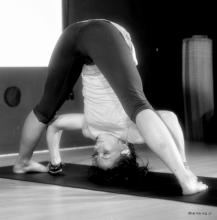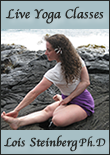Prasarita Padottanasana

Geometry: In this pose, the Feet are Spread Wide Apart. The Legs and Spine are Intensely Stretched.
Concave: The Feet are Parallel and Wide Apart. Hips OVER ankles. The torso extends Forward, parallel to the Floor. Wrists Underneath Shoulders.
Convex: The Feet are Parallel and Wide Apart. Hips OVER ankles. The torso extends forward and down. The feet, the hands, and the crown of the head are in line. Elbows are bent at 90 degrees above the wrists.
From Tadasana, Inhale, jump the legs 4 – 41/2 feet (wide) apart. Place the hands the hips. The feet are parallel. Tighten the legs by lifting the knee caps and quadriceps upwards.
Inhale lift the chest, Roll the shoulders back and away from the ears. Exhale place the palms on the floor underneath the shoulders.
Inhale, Draw the shoulder blades into the back. Exhale draw the abdomen into the spine.
Make space in the inner upper thighs from the inside out.
Press evenly into the feet. Draw the front thighs up and press them back. Exhale the hands to waist.
Inhale bring the torso back up to vertical. Exhale bring the legs back to Tadasana
Additional Points:
Press evenly into the inner and outer edges of the feet.
Press into the big toe mounds and internally rotate the top of the front thighs and externally rotate the inner back thighs out.
The inner thighs move away from one another.
Press the bottom of the shins back.
Take the thighbones back in the hip sockets.
Lift the arches of the feet up.
Take the outer shoulders back and draw the inner shoulder blades into the back.
Tailbone moves down and pubic bone lifts up towards the navel.
Classic Asana – Head Down.
Actions:
From Concave position, lift the chest and broaden the collar bones .
Place the palms of the hands in line with the feet. Spread the fingers and extend them towards the fingertips. Tighten the elbows and stretch the heels of the palms backward.
Exhale, bend the elbows and reach them back in line with the wrist and extend the crown of the head towards the floor. The weight of the body is in the legs.
Keep the head, palms, and feet in one line. Elbows draw in towards shoulder width and the shoulders lift up the back towards the hips. Press the hands and lift the shoulders to lift the hips and lengthen the sides of the waist.
Press the hands against the floor to straighten the arms, lift the head and look up, draw the shoulder blades in and down the back and lift the chest. Press the feet and come up from the waist with the spine extended.
Jump the feet together.
- This asana stretches the hamstrings and removes fatigue from practicing standing poses.
- People who cannot do sirsasana can benefit from this pose which increases digestive powers.
- All the standing poses help reduce body weight and build strength and stamina.
- This pose is soothing to the nervous system and is particularly recommended for Menopause. (YGFW, 93)
- Recommended for those with weak hearts and high blood pressure.
- The first stage with emphasis on the concave back gives more spinal extension. For back problems, the sequence of concavity for extension before taking the head down is beneficial. It is especially beneficial for women during menstruation and pregnancy. Resting the head on the floor allows for recovery.
- Learn to spread the legs apart without allowing the feet to slide and slip off.
- Learn to press the outer edges of the feet, like the application of the brake to a vehicle.
- Learn to concave the back using the arms and legs.
- Learn the two actions as separate stages. Look at the area on the floor where you are going to keep the crown of the head.
Place a block or a chair underneath the hands if you cannot keep the spine concave with the hands on the floor.
Common Problems
Hips are not in line with the Heels
Weight is in outer foot
Big toe mound is not pressing
Hands not able to reach floor
Shoulders roll forward
Spine is not concave
In convex position, abdomen and diaphragm are hardened and torso is not lengthened before coming forward.
If it is difficult to bend down while keeping the palms and the head in line with the feet, take the hands further forward and keep the head in line with the palms.
Are you a Yoga Teacher?
Are you a Yoga Student?
Do you Own a Yoga Studio?

